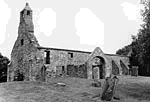|
Visit Abdie Church, Scotland
The remains of the old church of Abdie is found at Grange of Lindores, about a mile to the south of Newburgh. The Grange farmhouse is on the site of the Abbey farmhouse; the granary and centre for the agricultural produce for the monks.
In 1300, Abdie was referred to as Ebedyn, a modem descendent of an old ecclesiastical term denoting a 'shrine' connected with an abbey or monastery. As Abdie was known to have existed before Lindores Abbey was built the shrine probably bore some relationship to the ancient celtic foundation of Abernethy, of which all trace has been swept away.
In the foundation charter of Lindores Abbey by David Earl of Huntingdon in 1178, the first bequest made to the Abbey was the Church of Lindores (as Abdie was then known). The probable derivation of Lindores is Lann, sacred enclosure and Dobbar (pronounced dour), water hence Church by the water. Its altar (like Flisk Church) was dedicated to St. Ninian, a 5th century missionary while the building was dedicated to St. Adrian, a 9th century bishop of Abemethy whose name is also associated with Macduff s cross. There are several stones in and around the church that are of interest including a floreated cross found under the floor of the chancel and a 14th c. sculptured recumbent figure of an ecclesiastic clad in cassock and amice (hood with tassels).
In 1652, Sir Michael Balfour of Denmiln, comptroller of the Household of Charles I was buried here, and also his son, Sir James Balfour, Lyon. King of Arms is commemorated on a stone erected amongst various memorials in 1661 by Sir James' son, Robert, then ten years old acting under the guardianship of his uncle Michael Balfour of Pitmedden.
A much earlier artefact, at least 3rd century, can be seen in the church yard, in the form of the Lindores stone. This is a whinstone boulder 3ft. high and 17 ins. broad which used to stand on the adjoining ridge but removed in 1850. It is decorated with triple discs and a prominent crescent, two leaf-topped wands and a rod, perhaps of office. This stood near the site of McDuffs castle and not far from the Moot hill of Lindores. A moot was an assembly held for the purpose of trial and judgement. Here is where the Thane of Fife and his forbears and descendants stood and delivered judgement to the inhabitants of the surrounding region.
The Parish of Abdie in NW Fife stretches from Newburgh on the Firth of Tay to the Loch of Lindores. It includes the village of Lindores and the hamlet of Grange of Lindores, and in its churchyard near Grange of Lindores is a 7th-century Pictish symbol stone. Buried in the same churchyard are John Bethune (d.1839) and his brother Alexander (d.1843) who are remembered as local poets.
There is also a monument to Sir Frederick Lewis Maitland (1777-1839), captain of the British warship HMS Bellerophon which took the defeated Napoleon on board in 1815 prior to his exile in St Helena.
"Abdie parish, which is of considerable extent, but greatly intersected by other parishes, lies on the south bank of the river Tay, amongst those highlands to the westward, which have acquired the apellation of the Ochil hills. The surface is remarkably uneven, but the soil is in general fertile. It possesses three quarries of granite, of which considerable quantities are shipped for paving the streets of London. The parish is well watered with lochs, the chief of which is the lake of Lindores, about a mile in length, and of irregular breadth. This piece of water is well stored with fish, and being surrounded by some romantic scenery, is a beautiful object in the view of the country." from Slater's Directory, published 1852.
Home Page
|
|

